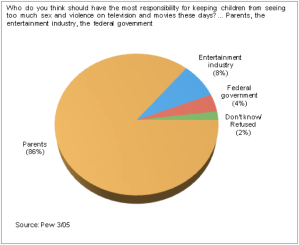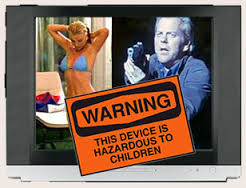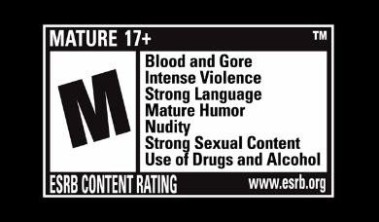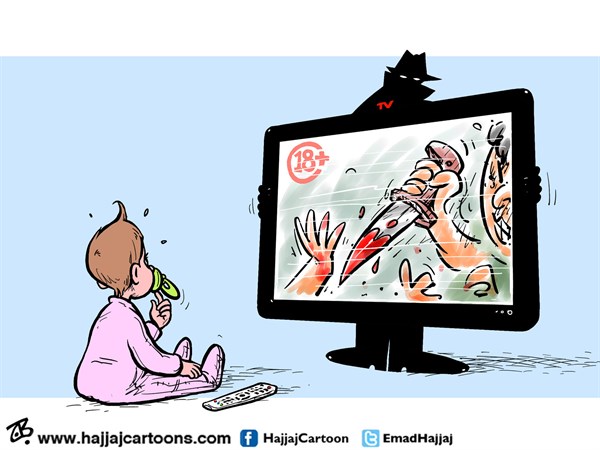 The figure to the left is a poll taken asking “Who do you think have the most responsibility for keeping children from seeing too much sex and violence on televisions and movies these days?” 86% answered with parents having the most responsibility and I agree. Parents need to be the ones who have the ultimate control on what their children watch. It is going to be too hard for television to regulate all the violence that occurs. It is the job of the parents to make sure that their children only view what they want them to see.
The figure to the left is a poll taken asking “Who do you think have the most responsibility for keeping children from seeing too much sex and violence on televisions and movies these days?” 86% answered with parents having the most responsibility and I agree. Parents need to be the ones who have the ultimate control on what their children watch. It is going to be too hard for television to regulate all the violence that occurs. It is the job of the parents to make sure that their children only view what they want them to see.
Author Archives: smcguire22
Growth of Violence on Television
Monkey See, Monkey Do — Violence Effects Kids
The more violence children are exposed to, the more they will think it is normal. Children are becoming “sensitized” to violence on television. They think it is “cool” and “normal”. They are becoming more engaged with this behavior and it is becoming more common in society.
Violence in the Media: Effects on Children
This video really describes how violence on television really affects children. It is a great display of the evolution of violence portrayed in movies and television. The growth of violence put into shows grew based on the growth of technology. It is interesting to see how effect of violence on children grew as scene became more graphic.

Affirmation: A Look into the Future with Violence on Television
As many people would think, early exposure to violence on television can led to violent behavior in the future. Huesmann et al conducted a study to find a relationship between the two. The study was done over 3 years and started with gathering data from 557 children around the world. They were observing their “TV-violence viewing, identification with aggressive TV characters, judgments of realism of TV violence, aggressive behavior, and intellectual ability, as well as parents’ socioeconomic status aggressiveness, parenting practices and attitudes, and parent’s TV usage” (Huesmann, 2003). Researchers gathered data from 320 participants ranging form 20-25. They measured adult TV violence viewing and their aggressive behaviors as adults. Comparing that to criminal records and moving violations of the participants the researchers found a relationship between the two. The results showed that exposure to TV violence as a child led to aggressive behaviors in both males and females and early TV viewing aggressions increase aggressions in adulthood.
This study is a perfect example of what we are arguing. The violence in television is doing more than just effecting children right now but will lead to even more aggression in their adulthood. Violent video games, exposure to school shootings and even aggression animated cartoon shows will lead to future problems. This is the problem we are trying resolve. Parents need to do a better job of monitoring what their children are watching. To cut down on future problems especially with children turning into aggressors in their adulthood, we need to look hard at the violence they are viewing on television and fix this before it escalates to a more worse situation.
Huesmann, L. R., Moise-Titus, J., Podolski, C., & Eron, L. D. (2003). Longitudinal relations between children’s exposure to TV violence and their aggressive and violent behavior in young adulthood: 1977-1992. Developmental Psychology, 39, 201-221.
Refutation: Supreme Justices Reject Ban on Video Games For Children
The article I have chosen to refute was written by Adam Liptak of The New York Times, entitled “Justices Reject Ban on Violent Video Games for Children.” In this article Adam gives some first hand accounts on the reasons behind the Supreme Court decisions for not making it illegal to sell violent video games to children under the age of 18.
Justice Antonin Scalia was quoted saying, “We have no businesspassing judgment on the view of the California Legislature that violent video games (or, for that matter, any other forms of speech) corrupt the young or harm their moral development” (Justices Reject Ban). However, numerous studies have been done that directly oppose this statement that show a rise in violent behavior directly after the use of violent video games. While no study can conclusively say that a school shooting or massacre like Newtown is directly correlated to a video game because there are often many variables at play, Craig A. Anderson, a psychologist at Iowa State University says, “If you look at the literature, I think it’s clear that violent media is one factor; it’s not the largest factor, but it’s also not the smallest” (Shooting in the Dark).
Next, Justice Scalia writes, “Depictions of violence have never been subject to government regulation. “Grimm’s Fairy Tales, for example, are grim indeed,” he wrote, recounting the gory plots of “Snow White,” “Cinderella” and “Hansel and Gretel.” High school reading lists and Saturday morning cartoons, too, he said, are riddled with violence” (Justices Reject Ban). This outlook on media is far too old school and doesn’t take into account that video games aren’t just a regular form of literature. These games are becoming so technologically advanced that one can create a player in their exact image and instead of reading about a killing or murder in a book, the user themselves make decisions on who and how to kill in the game. They have to power to meticulously plan out a violent act, which in my opinion is far more deviant then reading about it in Romeo & Juliet. When a user is able to actually perform the act of violence themselves, and see the graphic imagery of their opposition being mutilated it is going to have a far more lasting effect on them as a person than if they were to read about it in a story and I believe they should be treated differently as such.
“Justices Reject Ban on Violent Video Games for Children.” The New York Times. The New York Times, 27 June 2011. Web. 14 Apr. 2014. <http://www.nytimes.com/2011/06/28/us/28scotus.html?pagewanted=all&_r=0>.
“Shooting in the Dark.” The New York Times. The New York Times, 11 Feb. 2013. Web. 13 Apr. 2014. <http://www.nytimes.com/2013/02/12/science/studying-the-effects-of-playing-violent-video-games.html>.
Sex Vs. Guns
One can see that both sex and violence on TV is detrimental to our youth, but which do you believe to be the most harmful? Watch this video and we’ll let you be the judge!
More Violence, More Sex, More Troubled Kids
More Violence, More Sex, More Troubled Kids
A article outlining a new study done by the Parents Television Council on specific shows and how much sexual and violent content is being consumed while watching them.
Violence on TV by: Emad Hajjaj
Media Violence: Facts & Statistics
Media Violence: Facts & Statistics
The attached link published by the Media Education Foundation show statistics that are both alarming and eye-opening when it comes to the media consumption of sex and violence on television.







